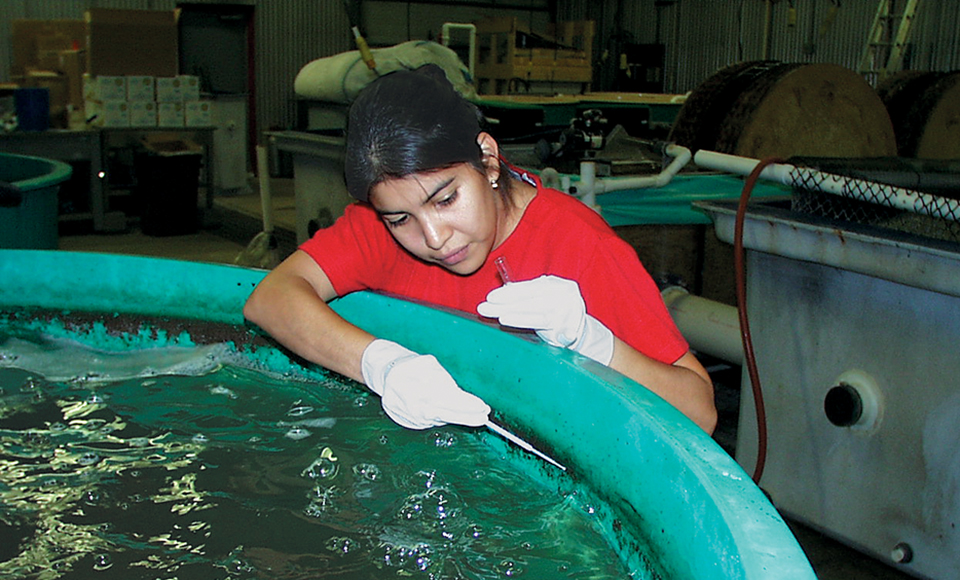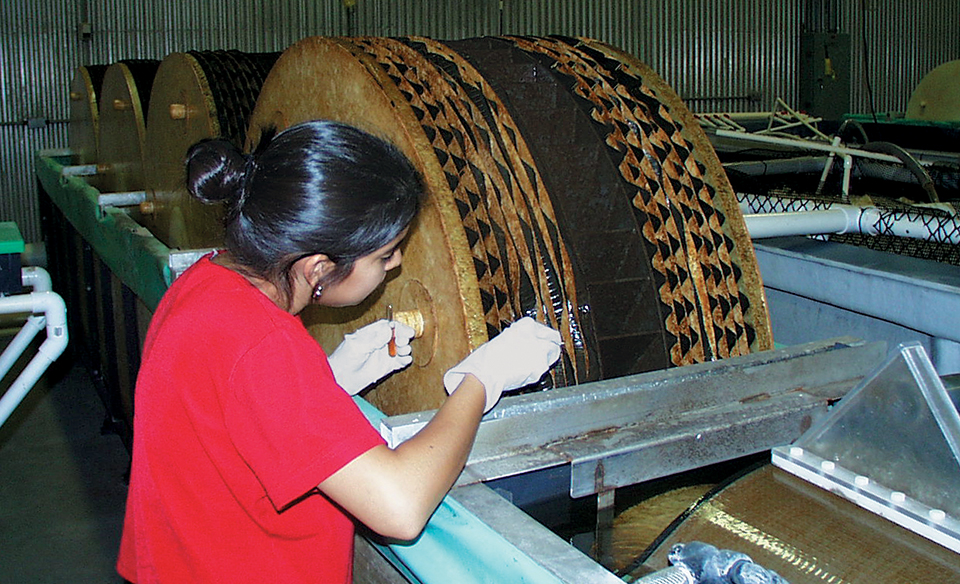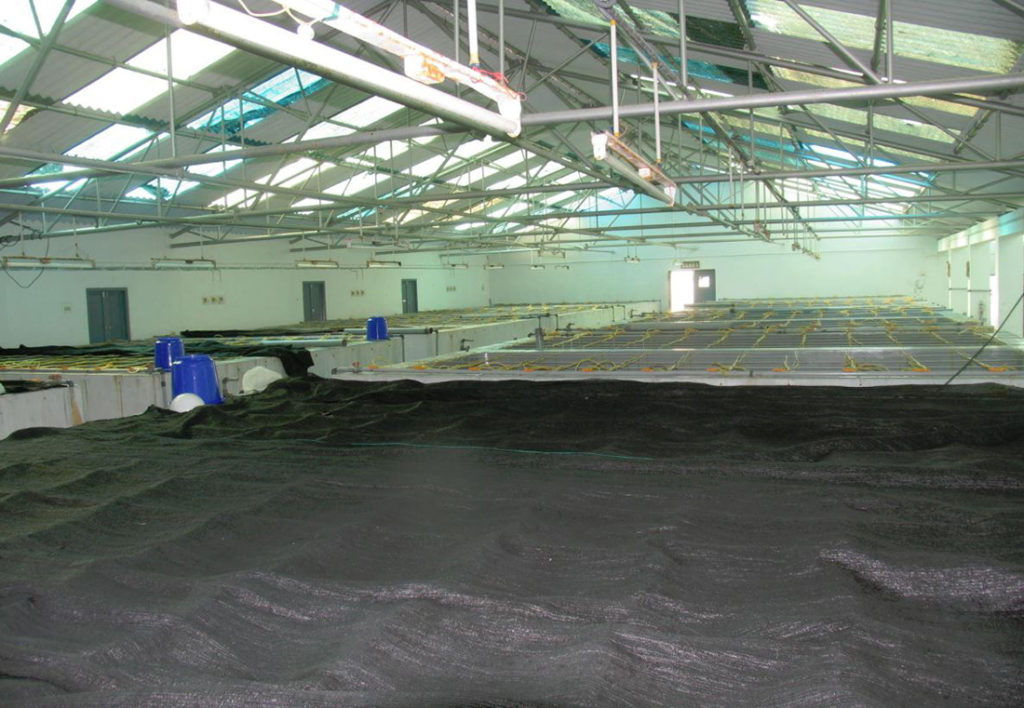Biosecurity measures can deter bacteria, fungi, algae and parasites

The rapidly growing recirculating aquaculture sector is generally independent of environmental conditions because most facilities are indoors. However, this form of aquaculture presents an increased potential for pathogenic bacteria to become established in the system through the formation of biofilms. Pathogenic bacteria released from biofilms are capable of causing recurring diseases in fish, as well as increasing exposure to humans.
Biofilms
Biofilms form at the water/solid interface of all components of aquaculture systems. They are also present in streams and on medical implants, and cause plaque on teeth. Biofilms have been found on the scales and skin of fish, and are of concern in the food industry, where there is evidence of biofilms on food contact surfaces.
Many different organisms are incorporated into biofilms, including bacteria, fungi, algae and parasites. Fluctuations of the dominant type of organism occur over time.
Bacterial biofilms are used in wastewater treatment plants in some countries to aid in cleaning water. Some bacteria found in aquaculture system biofilms are essential in the removal of ammonia and nitrites, metabolic waste products harmful to fish.
Studies have shown that bacteria in biofilms adapt to adverse environmental conditions by altering their cellular functions. Biofilm bacterial cells have been found resistant to antimicrobials treatments, including antibiotics, surfactants or detergents, heavy metals, phagocytic predators and drying.
Potential risks
The presence of human pathogenic bacteria in a recirculating aquaculture system can make the system a potentially unacceptable public health risk. The periodic sloughing of piscine pathogens can also cause recurring disease in stressed fish. These fish can be asymptomatic and enter the food chain. If any cross-contamination occurs during processing, finished products can be contaminated, leading to the possibility of infection in the consumer.
Another hazard is that symptomatic fish are often given antibiotics in feed or treated with antimicrobials in the water. Bacteria in biofilms can develop resistance to these antimicrobials, and if infection occurs, normal methods of treatment may not be as effective.
Bacterial pathogens
Table 1 lists some bacterial pathogens isolated from biofilms in aquaculture facilities. Most of these organisms are opportunistic pathogens, and all of them are ubiquitous in the environment. Some of the more significant human pathogens are Bacillus cereus, Shigella spp., and Vibrio spp.
King, Pathogenic bacteria associated with biofilms, Table 1
| Bacterium | Risk |
|---|---|
| Acinetobacter spp. | H |
| Aeromonas hydrophila | F/H |
| Aeromonas spp. | F/H |
| Bacillus cereus | H |
| Bacillus spp. | F/H |
| Citrobacter freundii | F/H |
| Enterobacter cloacae | H |
| Enterococcus spp. | H |
| Escherichia coli | H |
| Photobacterium damsela | F/H |
| Plesiomonas shigelloides | F/H |
| Serratia marcescens | H |
| Shewanella putrefaciens | F/H |
| Shigella spp. | H |
| Sphingobacterium multivorum | H |
| Sphingomonas spp. | H |
| Vibrio spp. | F/H |
| Vibrio cholerae | H |
Bacillus cereus
Bacillus cereus is becoming more of a concern in the food industry because it is a hardy, spore-forming organism capable of surviving harsh conditions, including high temperatures. B. cereus ingestion can lead to vomiting or diarrhea after the spores germinate and produce either emetic toxin or diarrheic toxin. This bacteria can also cause ocular or wound infections, septicemia, and other nonspecific central nervous system or respiratory infections, though presentation of these symptoms is not common.

Shigella spp.
Shigella spp. cause dysentery and are generally associated with poor sanitation. These bacteria have a low infectious dose, which facilitates rapid transmission, especially in crowded, unsanitary conditions. Fecal matter from infected individuals contaminates food and water.
Vibrio spp.
Three major species of Vibrio lead to infections in humans: V. cholerae, V. parahemolyticus, and V. vulnificus. Commonly found in water, Vibrio cholerae can persist in shellfish and plankton beds that have been contaminated with polluted effluent. This species contains many harmless aquatic strains, as well as the more virulent strains that are responsible for the gastrointestinal illness cholera. Cholera is another disease related to poor sanitary conditions. It is transmitted primarily by contaminated water and food.
Vibrio parahemolyticus can also cause gastrointestinal distress when undercooked or raw seafood has been consumed. V. parahemolyticus is widely distributed in coastal waters and associated with every type of seafood. It is more prevalent in warmer seasons, but can be isolated from cold water.
Vibrio vulnificus is associated with wound infections and septicemia in humans, though usually only in immunocompromised patients. Septicemia is primarily associated with consumption of raw oysters. Death rates for septicemic patients can be quite high. The organism is less often associated with gastrointestinal illness, and its role in causing gastroenteritis is not well understood.
Vibriosis
Vibriosis also occurs in fish. It is most common in marine fish, but can also be present in freshwater fish. Disease outbreaks of vibriosis in fish vary with temperature, strain virulence and the amount of environmental stress present.
Conclusion
Many types of microorganisms are incorporated into biofilms in recirculating aquaculture systems. Although these organisms are an essential part of the systems’ biofiltration, bacterial pathogens can also be present. Occasional sloughing of the biofilm can release these pathogens into the water, exposing fish and humans to infection.
Some organisms of primary concern to humans include B. cereus, Shigella species and Vibrio species. These pathogenic bacteria can cause gastrointestinal disease, wound infection, and/or septicemia in humans.
Exposure to humans can result from cross-contamination of infected fish with finished products during processing, or direct exposure to water. Because many of the pathogenic bacteria in biofilms are common in the aquatic environment, elimination is an unrealistic goal. Decreasing the number of pathogens present is more attainable. Appropriate biosecurity measures decrease the risk of exposure to both fish and employees.
(Editor’s Note: This article was originally published in the October 2002 print edition of the Global Aquaculture Advocate.)
Now that you've reached the end of the article ...
… please consider supporting GSA’s mission to advance responsible seafood practices through education, advocacy and third-party assurances. The Advocate aims to document the evolution of responsible seafood practices and share the expansive knowledge of our vast network of contributors.
By becoming a Global Seafood Alliance member, you’re ensuring that all of the pre-competitive work we do through member benefits, resources and events can continue. Individual membership costs just $50 a year.
Not a GSA member? Join us.
Author
-
Robin K. King, DVM, Ph.D.
VETCOM Food Analysis and Diagnostic Lab
2472 Schofield Road
Fort Sam Houston, Texas 78234 USA[108,105,109,46,121,109,114,97,46,100,100,101,109,97,46,110,108,64,103,110,105,107,110,105,98,111,114]
Tagged With
Related Posts

Health & Welfare
A comprehensive look at the Proficiency Test for farmed shrimp
The University of Arizona Aquaculture Pathology Laboratory has carried out the Proficiency Test (PT) since 2005, with 300-plus diagnostic laboratories participating while improving their capabilities in the diagnosis of several shrimp pathogens.

Health & Welfare
A holistic management approach to EMS
Early Mortality Syndrome has devastated farmed shrimp in Asia and Latin America. With better understanding of the pathogen and the development and improvement of novel strategies, shrimp farmers are now able to better manage the disease.

Health & Welfare
A study of Zoea-2 Syndrome in hatcheries in India, part 1
Indian shrimp hatcheries have experienced larval mortality in the zoea-2 stage, with molt deterioration and resulting in heavy mortality. Authors investigated the problem holistically.

Health & Welfare
A study of Zoea-2 Syndrome in hatcheries in India, part 3
In this third and final part, authors present recommendations to help reduce the incidence of Zoea-2 Syndrome, which is not caused by any known infectious agents in P. vannamei hatcheries in India.



